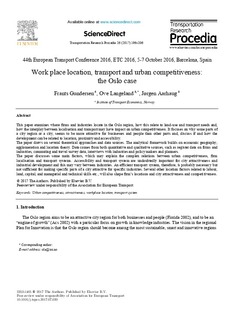| dc.contributor.author | Gundersen, Frants Henrik | |
| dc.contributor.author | Langeland, Ove | |
| dc.contributor.author | Aarhaug, Jørgen | |
| dc.coverage.spatial | Norway | nb_NO |
| dc.date.accessioned | 2019-06-26T13:53:19Z | |
| dc.date.available | 2019-06-26T13:53:19Z | |
| dc.date.created | 2017-09-19T15:49:22Z | |
| dc.date.issued | 2017-08-14 | |
| dc.identifier.citation | Transportation Research Procedia. 2017, 26, 196-206. | nb_NO |
| dc.identifier.issn | 2352-1465 | |
| dc.identifier.uri | http://hdl.handle.net/11250/2602398 | |
| dc.description.abstract | This paper examines where firms and industries locate in the Oslo region, how this relate to land-use and transport needs and, how the interplay between localisation and transport may have impact on urban competitiveness. It focuses on why some parts of a city region or a city, seems to be more attractive for businesses and people than other parts and, discuss if and how the development can be related to location, proximity and accessibility.
The paper draws on several theoretical approaches and data sources. The analytical framework builds on economic geography, agglomeration and location theory. Data comes from both quantitative and qualitative sources, such as register data on firms and industries, commuting and travel survey data, interviews with industries and policy makers and planners.
The paper discusses some main factors, which may explain the complex relations between urban competitiveness, firm localisation and transport systems. Accessibility and transport system are undoubtedly important for city attractiveness and industrial development and this may vary between industries. An efficient transport system, therefore, is probably necessary but not sufficient for making specific parts of a city attractive for specific industries. Several other location factors related to labour, land, capital, and managerial and technical skills etc., will also shape firm's locations and city attractiveness and competitiveness. | nb_NO |
| dc.language.iso | eng | nb_NO |
| dc.publisher | Elsevier | nb_NO |
| dc.rights | Attribution-NonCommercial-NoDerivatives 4.0 Internasjonal | * |
| dc.rights.uri | http://creativecommons.org/licenses/by-nc-nd/4.0/deed.no | * |
| dc.title | Work place location, transport and urban competitiveness: The Oslo case | nb_NO |
| dc.title.alternative | Work place location, transport and urban competitiveness: The Oslo case | nb_NO |
| dc.type | Journal article | nb_NO |
| dc.type | Peer reviewed | nb_NO |
| dc.rights.holder | © 2017 The Authors. Published by Elsevier B.V. | nb_NO |
| dc.description.version | publishedVersion | nb_NO |
| cristin.unitcode | 7482,1,3,0 | |
| cristin.unitname | Regional utvikling og reiseliv | |
| cristin.ispublished | true | |
| cristin.fulltext | original | |
| cristin.qualitycode | 1 | |
| dc.identifier.doi | 10.1016/j.trpro.2017.07.020 | |
| dc.identifier.cristin | 1495522 | |
| dc.source.journal | Transportation Research Procedia | nb_NO |
| dc.source.volume | 26 | nb_NO |
| dc.source.pagenumber | 196-206 | nb_NO |

